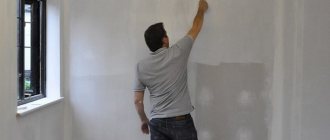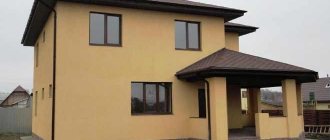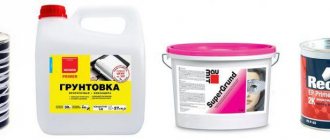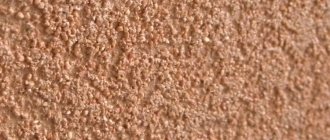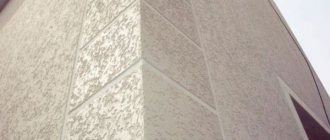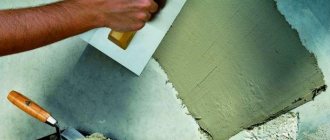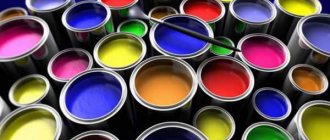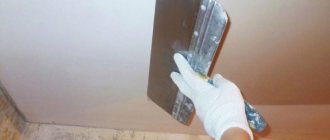Tools and materials
Decorative bark beetle plaster, in addition to standard ones, requires the use of several specific finishing tools. The list of required materials is quite short.
Texture of bark beetle plaster
- roller;
- brush;
- cuvette;
- drill with mixer;
- Master OK;
- wide and narrow trowel;
- polyurethane grater.
- primer;
- ready-made or dry bark beetle plaster.
Ready-made bark beetle plaster
Preparatory operations and application of the mixture
Decorative bark beetle plaster requires a leveled base. Before applying the texture, the wall must be leveled using traditional methods: continuous leveling, sanding. The smooth surface is carefully primed. Application of decorative bark beetle plaster can be done after the primer has completely dried, which may take from several hours to one day.
In the technology of applying bark beetle plaster, correct mixing of the mixture is important. The instructions for use on the packaging indicate the required proportion of dilution of dry putty with water. It must be followed exactly. Thus, decorative bark beetle plaster Ceresit CT-35 requires 5.5-6 liters of water to mix 1 bag weighing 25 kg. You need to mix the whole bag at once. Determining the ratio for a partial batch is difficult. Bark beetle facade plaster is also offered in finished form. This way it costs more, but is guaranteed to have the correct consistency.
Application technology
Decorative bark beetle plaster is not applied with a spatula. A wide trowel is used for this. Using a trowel, scoop a good portion of the mixture from the container and place it on the working surface of the trowel. Decorative bark beetle plaster should be applied using vertical movements from bottom to top. The mixture is distributed in strips over the surface of the wall.
The layer is determined by the size of the filler grains. The thickness of the application should approximately correspond to it. You can navigate by the nature of the distribution over the surface. If transverse waves are formed, the layer is insufficient. When the solution begins to drag behind the tool, this indicates excess thickness. You can adjust it by the angle of inclination of the trowel to the wall. A sharper angle allows you to apply more solution. As the angle increases, the layer decreases.
The consumption of plaster directly depends on the thickness of the layer. When choosing a mixture with 3.5 mm grains, keep in mind that you will need more of it than for a composition with 2.5 mm aggregate. Thus, for the Ceresit CT-35 mixture, the plaster consumption will be 4.9 and 3.5 kg/m², respectively.
Applying "Bark Beetle" to the facade of the house
Applying “Bark Beetle” to the façade is a fairly simple stage of work. But you still need to be patient.
The work is carried out using a grater. Place the grater at an angle of 60 degrees to the work surface
, it is necessary to apply a decorative finish to the wall of the house, as shown in the photo, in a thin, uniform layer and smear it. The thickness of the layer should be equal to the diameter of the bark beetle grain. After the material has thickened a little (about 30 minutes), you can begin to level the layer on the wall of the house and apply the design.
The pattern can be different - horizontal or vertical stripes, crossing or circles
. Here you can give free rein to your imagination. You need to apply a decorative pattern to the facade of a building with soft, smooth movements, preferably at once. The more often you pass the float over the surface of the house, the more invisible the pattern will be.
Recommended operating temperature is from +5 to +25 degrees. But if you are working with colored finishes, then the temperature of the house should not be lower than +10 degrees. When working with decorative finishing, it is better to forget about breaks for lunch or snacks; it is better to treat the surface in one go.
"Bark beetle" dries
on the walls of the house in different ways. It depends on the manufacturer and brand. This can be seen in the photo of the “Bark Beetle”, which is usually given in the instructions. Typically the drying time is 1-5 days. After this period (provided it has completely dried), you can begin painting the walls of the house.
Despite the fact that textured bark beetle plaster appeared on the market of finishing materials relatively recently, it almost immediately gained enormous popularity. Its numerous advantages attracted the attention of professional builders, designers and simply apartment owners. Therefore, today you can see it in a variety of places - offices, hospitals, residential entrances. Let's find out what characteristics it has.
Formation of invoice
Applying decorative bark beetle plaster should take no more than half an hour. Then the solution begins to set. After this time, you need to start creating the texture. Bark beetle facades can have 2 types of patterns:
Take a polyurethane grater, place it flat on the wall and roll the grains into the coating mass using vertical or circular movements. You need to go from the edge where you started applying. Traces remain behind the grains, which are perceived as a drawing. Excess solution is removed from the grater with a narrow trowel. Do not dump it into a container with a fresh portion of the mixture. This speeds up the setting of the new batch.
Vertical pattern of rain
It is advisable to complete the finishing of the entire façade of a house with bark beetle in one go; the transitions on this type of coating are too noticeable.
If you decide that you can do bark beetle plaster with your own hands, do not forget to find yourself an assistant. For a novice master, it is worth choosing the “rain” option. It is made easier and faster.
The main mistakes amateurs make when applying decorative coatings are:
- poor preparation of the base and application on uneven surfaces;
- using the wrong tool;
- errors when mixing the mixture;
- instability or incorrect choice of layer thickness;
- breaks in work within one wall;
- lack of speed and drying out of the mixture (working in the sun or in windy weather speeds up setting).
The list is impressive, but not everything is so scary. The task is quite feasible even with a lack of experience.
Circular plaster bark beetle
Preparing the mixture
If you use Ceresit dry mixture, then preparing the plaster is easy.
You need to remember a few simple rules:
- The optimal water temperature is 15-20° Celsius.
- You need to pour the plaster into the water, stirring continuously, and not vice versa.
- The mixture must be stirred as thoroughly as possible throughout the entire volume - it is best to use a construction mixer for this.
- When the mixture reaches the desired consistency, you need to let it sit for a few minutes, then stir again and get to work.
Obviously, there is nothing complicated about how to make bark beetle plaster with your own hands.
Primer for bark beetle - technology and application nuances
What primer should I apply under decorative bark beetle plaster, and how should I do it correctly? I used to think about this question myself, but now, having some experience and knowledge behind me, I’m ready to answer it in detail. And the photo instructions will allow you to visually familiarize yourself with the application process.
Before applying the bark beetle, the walls must be treated with a primer.
Is it necessary to prime the base before the bark beetle?
Many beginners ask experts whether a primer is really necessary before the bark beetle? After all, priming takes time and increases financial costs.
To answer this question, below I will list what functions the soil performs:
- Improves adhesion . The primer provides good adhesion of the primer to the surface, and accordingly increases the durability of the finish. It must be said that this quality is of particular importance when applying plaster to smooth surfaces such as concrete;
The primer improves the adhesion of decorative plaster to smooth walls and ceilings
- Strengthens the surface . The soil penetrates the pores of the base and glues them together, thereby strengthening the surface. This quality is important for loose/porous surfaces;
- Provides uniform moisture absorption . The primer forms a film on the surface, due to which moisture is absorbed evenly and, accordingly, the decorative plaster dries evenly. It must be said that for the bark beetle, uniform drying is of great importance, since the quality of the grout largely depends on this;
What primer to use
Currently, the following types of primers can be found on sale:
What power tool is used to apply plaster?
Andrey, for mechanized plastering, mortar pumps and hoppers with nozzles are used, into which soft and hard mortars are placed. The pouring machine has a steel container for scooping the solution. Four nozzles are used to supply the mixture, 4 for air. For ease of use, the holding tube is covered with a material that prevents your hands from slipping. It has a valve for supplying compressed air. The pneumopath has an average labor productivity of 60 square meters per hour.
Such units can be wall-mounted or ceiling-mounted - they differ in the shape of the bucket and its location relative to the holder. The pneumatic gun has a short nozzle barrel with nozzles through which the mixture is sprayed onto the surface using various methods. The top of the cartouche pistol is equipped with a container in the form of a plastic or metal funnel with a volume of 5 liters. The handle in current equipment has a trigger that allows you to carry out or stop the supply of the solution. It looks like an airbrush. At the bottom of the handle there is a branch for connecting an air hose to the compressor.
Different nozzles make it possible to use compositions of different consistencies. Adjusting the supply of mixture and air allows you to level the surface and apply textured spray (for decorative finishing). The construction equipment market is characterized by an abundance of machines for applying mortar using the mechanized method. Each of the machines has its own technical parameters, dimensions and equipment. German units are compact in size and allow, in addition to supplying the solution, painting.
Technology of applying primer Ceresit before Bark beetle
Everything you wanted to know about primer but were afraid to ask
Primer is one of those materials whose “service is both dangerous and difficult, and at first glance seems invisible.” It performs a lot of functions, but it always remains under a layer of paint, wallpaper or other types of finishing. In this article we will talk about what a primer is, what it is like, how to choose the best one and other interesting and useful things.
A primer is a building material that is applied to various surfaces before finishing work begins. It plays the role of a connecting link between the treated surface and the finishing layer (plaster, wallpaper glue, etc.), promoting their uniform distribution and a longer service life of the finish due to its adhesive properties. In addition, the primer can have anti-corrosion and anti-fungal properties, protect the surface from the negative influence of environmental factors, and pigments can be added to it to control the evenness of the layer application. Thanks to the application of a primer, it is possible to significantly save on finishing materials.
The primer can be sold in different forms. These are mainly: dry mixtures, packaged in bags or boxes, and liquid or paste, packaged in cans or buckets. Dry soils require preliminary preparation for work. It consists of diluting with liquid. Paste and liquid mixtures are immediately ready for use and do not require any additional preparation.
There are mixtures specified for machine or manual application, as well as universal ones.
The range of use of primer compositions is very wide; it can be used on brick, concrete, wood, metal, foam block, aerated concrete, particle board and wood fiber, gypsum fiber and plasterboard, stone (including limestone), gypsum and plastered bases.
In interior decoration, the purpose of using a primer is to bind the surface to the decorative finish. The use of primer in exterior finishing usually aims to protect certain structures from the effects of the external environment.
The primer mixture is divided according to purpose into the following types:
- Universal – suitable for any materials. Its main advantage is good adhesion to most types of surfaces and finishing materials, but on average its characteristics are inferior to each of the special compositions.
- For wood - this mixture is used to protect the tree from pests, fungus, humidity and similar adverse effects. It gives the material smoothness and saves paint.
- For metal - mainly used for ferrous metals such as cast iron, nickel-plated iron-based alloys, steel. Has good anti-corrosion properties.
- For mineral bases - this variety finds its application in the field of strengthening porous surfaces, for example, plaster or concrete. It has high penetrating properties, increases the ability of the material to withstand environmental influences, and saves the consumption of finishing materials. Often this mixture includes an antifungal component that prevents the development of mold.
Another basis for classifying primer compositions is their type:
- Antifungal - this mixture is used in rooms with insufficient ventilation and high humidity, where mold easily grows (for example, in bathrooms).
- Anti-corrosion – used for treating metal surfaces (mainly ferrous metal, since non-ferrous metals themselves are quite resistant to corrosion) in order to avoid the formation of rust. Has a high degree of resistance to environmental influences.
- Deep-penetrating - this type of primer is intended for use before finishing porous and old surfaces such as drywall, plaster, putty. Often fungicidal components are introduced into it, which help combat the development of fungus. In appearance it resembles a cloudy solution.
- Insulating – this primer is designed to combat high humidity, used for interior and exterior work. It is well suited for porous surfaces. The materials processed by it acquire durability. One of its main advantages is vapor permeability.
- Primer-paint is a universal composition that combines the characteristics of a primer and paint, suitable for many types of surfaces, both smooth and porous. Well suited for thermal insulation, waterproofing, finishing and other types of work. It has anti-corrosion properties and prevents excessive water absorption.
- Primer varnish - this composition has a combination of the properties of a primer and varnish. It is well suited for use on wooden surfaces that will then be sanded. Can be used as a finishing finish where there is no strong mechanical impact. It is moisture resistant and not affected by detergents. Used for interior work.
- A special primer is used to save finishing materials and strengthen the finishing layers. It is characterized by strength and resistance to external influences, but it does not have decorative properties and is used only for cladding.
Types of paint for bark beetle
There is no special coating for the “bark beetle” texture. The working material is selected depending on where the repair will take place. Bark beetle paint for facade and interior work is used depending on its purpose. And how to paint this or that surface is up to everyone to decide for themselves.
Oily
Oil paint is the most popular, as it has a wide range of uses and is inexpensive. It can be used to paint any materials, including bark beetles.
The viscosity of the dye is given by drying oil, which is now produced synthetically. Mineral flour is added to the suspension as a filler, and inorganic pigments give the paint the desired color. Using a solvent, the required consistency of the composition is obtained.
Oil paint can be used to paint any materials, including bark beetles.
Oil dyes are distinguished by rich colors and shades, but have disadvantages:
- low moisture exchange prevents the evaporation of moisture from building materials;
- react with alkalis;
- low fire resistance;
- unpleasant odor, toxic to humans;
- Over time, the paint fades and loses its shine.
Due to its shortcomings, this “outdated” paint has been replaced by more modern options.
Acrylic
The paint is based on polymers of acid esters. When diluted, it can be tinted with aqueous pastes containing pigments, but after drying it becomes waterproof. This paint has a lot of positive qualities:
- durability;
- wide color palette;
- vapor permeability.
May be toxic when applied. Used in painting and by painting specialists.
Acrylic paint is based on polymers of acid esters
Textured
It is a viscous dense mass based on acrylic and polymer components. Fillers can be sand, granite and marble chips, crushed gas silicate and polymer fibers. A very unusual paint in texture: it imitates wood worn away by insects. Suitable for indoor and outdoor work, characterized by:
- durability;
- vapor permeability;
- frost resistance.
This finishing material is used as paint and putty at the same time. Hides surface cracks and other imperfections.
Disadvantages include high cost and material consumption. And the master will need skill when working.
Textured paint is used as paint and putty at the same time
Alkyd
A widely used paint and varnish material based on synthetic alkyd resins. It includes:
- film formers (glyphthalic and pentaphthalic);
- solvents (white spirit, toluene, solvent);
- fillers (marble or lime chips, silicates and other minerals);
- additives (driers, plasticizers, stabilizers)
With its low price, durability, vapor permeability and resistance to temperature changes, it has a long-lasting unpleasant odor, which is why it is used more often for facade work.
Widely used paint and varnish material based on synthetic alkyd resins
Structural
It is also called textured. It can be used to paint a surface that is not perfectly level, as its texture can hide many imperfections. Over time, the color will not lose its original appearance. After drying, a film is formed that will extend the service life of the coating.
It differs from conventional paint in consistency, appearance, and high cost. Its synthetic fibers, quartz sand, stone chips and other additives create texture on the surface.
The painted surface imitates crocodile skin, marble, velvet, wood. This property allows you to experiment and create new drawings. Apply to any surface with different textures and textures.
Structural paint can be used to paint a surface that is not perfectly level, as its texture can hide many imperfections
Silicate
The binder of the composition is glass, thanks to which dust does not stick to the paint. In addition, the mixture sometimes includes fine silicon powder, zinc, and aluminum, which gives the consistency anti-corrosion properties. This dye also contains crushed minerals that are resistant to alkalis. The paintwork received its name due to the presence of sodium and potassium silicates in it.
The service life of the coating is at least 20 years, and all these years it looks like new. The loose structure of the paint allows moisture to evaporate freely. It is fireproof, resistant to UV radiation, temperature changes, and has a matte texture. Painted surfaces are not susceptible to the growth of mold and other microorganisms.
But there are also disadvantages to this texture:
- lack of elasticity does not fill small cracks;
- due to high toxicity, you should work in personal protective equipment;
- if necessary, it will not be possible to remove it, since its high strength will not allow this.
Mainly used for facade decoration.
In silicate paint, the binder of the composition is glass, thanks to which dust does not stick to the paint
Mineral
This paint contains crushed minerals that serve as pigment. It is sold in powder form, which is diluted with water to the desired consistency before use. Mineral mixtures have many advantages:
- are an environmentally friendly product;
- have vapor permeability;
- resistant to frost and high temperatures;
- with the introduction of synthetic resins, adhesion, hiding power, water resistance, ductility and resistance to particle settling increase.
In turn, mineral dyes are divided into:
- limestone;
- cement;
- silicate;
- oil
When dry, the composition becomes very durable.
Mineral paint contains crushed minerals that serve as pigments.
Silicone
A painting product containing resins and an emulsion of water. The paint is environmentally friendly in any condition and can be applied even in rooms with high humidity, as its water-repellent property allows it. Odorless, universal for all surfaces. Combines the advantages of acrylic and silicate paints.
Due to its elasticity, the dye will fill any gap. Dust does not stick to it and dirt is easily removed.
Very durable, service life reaches 20-25 years.
Silicone paint contains resins and an emulsion of water
Decorative bark beetle plaster: features of application technology
One of the frequently used types of decorative design of building facades is the so-called “bark beetle” textured plaster. Today it is used almost everywhere, and there are several reasons for this: firstly, buildings finished in this way look attractive; secondly, this is a relatively cheap facade finishing technology; and thirdly, if desired, it is very easy to implement it yourself. It is this technology that we will consider in this article. Now, together with the website stroisovety.org, we will study in detail the question of how to apply decorative bark beetle plaster with your own hands, and we will also pay special attention to all the subtleties of this process, of which there are many.
Decorative plaster bark beetle photo
How to choose bark beetle plaster
Before you begin decorative finishing, you need to choose the material with which you will work.
. Bark beetle plaster, a photo of which can easily be found, is usually sold in two forms - in bags in the form of a dry powder or in buckets in the form of a paste mixture. It is easier to work with the ready-made mixture, but it is more expensive than powder, because it contains synthetic fillers (acrylic or silicone).
When purchasing plaster, special attention should be paid to the composition
. Different manufacturers usually have the same composition. If the manufacturer does not violate the technology for preparing the mixture, then there is no significant difference in the composition. All you have to do is choose a manufacturer you trust - domestic or European. It's a matter of your taste here.
But you shouldn't skimp on quality. Carefully read the composition and finished samples. You can even find a photo of the “Bark Beetle” plaster and carefully examine it. And only after detailed study make a choice.
We must not forget about the diameter of the marble chips, because it is
the grain of the plaster that is responsible for the texture of the finished surface
. When choosing a grain size, you need to take into account this feature - for decorative plaster, the consumption depends on the diameter of the marble grains. Thus, the material consumption with a fraction diameter of 0.1 mm will be greater than with a grain diameter of 4 mm.
How to prepare the base for applying decorative bark beetle plaster
I think it’s no secret to anyone that decorative bark beetle plaster and similar coatings are applied exclusively to dense surfaces. As a rule, the application of such finishing material to the walls is preceded by long and painstaking work to level the base. For the most part, in modern construction, bark beetle is used to finish external walls insulated with foam plastic or basalt slab - this is the technology that allows one to avoid painstaking work on leveling the base.
Polystyrene foam or high-density basalt slabs are attached to the wall like tiles, which allows you to solve two problems in one fell swoop - insulating the house and leveling the outer walls. Subsequently, the foam plastic is reinforced, plastered with a very thin layer, and only then decorative bark beetle plaster is applied.
How to prepare the base before applying bark beetle plaster
This is where we will begin in detail. Even before applying the bark beetle plaster, the surface of the plastered walls must be properly primed (it does not matter whether it is polystyrene foam or cement-sand plaster). An ordinary deep penetration primer is not suitable here - you need a special liquid, which includes quartz sand. If we are talking about the products of the Ceresit company, then it is difficult to find anything better than paint-primer ST-16 - it is the one that is capable of ensuring high-quality adhesion of bark beetle plaster to any surface, and at the same time depriving the base of the ability to absorb moisture.
By the way, this type of primer is used to preserve the plastered surface for the winter. This is in case someone did not have time to complete the finishing of the facade and postpones the application of decorative coating to the next season. Do not underestimate this step - temperature changes and humidity can quickly destroy the thin layer of glue applied to the foam or basalt slab. Such natural phenomena will simply tear both the plaster and the reinforcing mesh.
Primer Ceresit ST-16 before applying bark beetle photo
But let’s return to the technology of applying bark beetle and its subtleties.
How to apply decorative bark beetle plaster with your own hands
First, a short excursion into this finishing material. Plaster of this type can be produced either in finished form or in the form of building mixtures. The first of them is made on the basis of acrylic, and it is quite difficult to work with it - if we are talking about applying bark beetle plaster with your own hands, then it should be abandoned in favor of dry construction mixtures. Working with the latter is a little easier, and there are fewer subtleties here.
Application of decorative plaster bark beetle photo
To prepare the dry mixture, you don’t need a lot of intelligence - it is simply poured into water and stirred with a construction mixer. As a rule, the consistency of such a solution should resemble thick sour cream. A thinner or thicker solution is more difficult to apply - in this regard you will have to experiment a little. I want to warn you right away that you should not tint such a solution. Only acrylic mixture is tinted, and this type of decorative plaster is painted after drying.
DIY decorative bark beetle plaster
Facade decorative bark beetle plaster is applied to the walls first with a wide spatula (300-400mm), and then rubbed with a wooden grater or falcon. The most important thing in this process is rubbing; only with the help of a grater can you give a certain structure to the surface of the walls. As a rule, rubbing the bark beetle on the wall is done either in a circular motion or by moving the falcon up and down. It all depends on what kind of structure you want to get. It should be understood that the structure of this plaster is achieved through small smooth balls added to the dry mixture - both the depth and width of the grooves depend on the balls. This nuance must be taken into account when choosing building mixtures.
How to apply bark beetle with your own hands photo
Characteristics of bark beetle plaster
“Bark beetle” from different manufacturers basically has a similar composition
. Usually it includes cement and marble chips of various fractions. Thanks to the small grains, the effect of a tree damaged by a beetle is created.
Marble fractions can be of various sizes from 0.1 mm to 4 mm
. When applied with a spatula, grains of marble “scratch” the base, thereby giving the plaster its shape. The depth and width of the furrow directly depends on the size of the fraction. Plaster with a large diameter of marble grains is popular.
Since the material is used for both interior and exterior decoration of the building
, then it must have characteristics that will ensure not only beauty, but also practicality of the coating. In this regard, “Bark Beetle” plaster copes well with the given conditions.
"Bark beetle" has great heat resistance
, thanks to which it tolerates both low and high temperatures (from -55 to +60 degrees). Plaster is not susceptible to weather conditions - it does not fade in the sun, does not weather, and does not get wet in the rain.
This type of plaster is very difficult to damage or scratch. All this allows you to keep the coating in excellent condition for a long time. In the interior, such plaster will last up to 15 years.
Most often, "Bark Beetle" is produced in white color. But there are many paints compatible with this coating.
, which are added when diluting the mixture. Different shades will add richness to the plaster and make the interior unique. In addition, the paint can be applied to an already finished coating, so “Bark Beetle” allows you to choose a large number of colors. The finished plaster can be washed with a rag, brush or even a vacuum cleaner.
Subtleties and nuances of applying bark beetle
If you think that this work is replete with all sorts of subtleties, you are deeply mistaken - there are few of them, but in order to obtain a high-quality coating, it is necessary to observe these features.
- Firstly, you need to work in planes, not square meters. If you start finishing one wall, then you need to finish it, no matter how big it is. If you see that you can’t cope, make a dividing strip - masking tape is applied from top to bottom along the wall in an even strip, which is removed immediately after applying the plaster (on freshly). After you decide to continue working, the same tape must be glued along the edge of the already dry surface. Why such difficulties? It’s simple - if you don’t use this separation technology, then even after painting the facade, the junction of two different sections will be noticeable.
- Secondly, again, in order to have time to finish the started plane, it is better to work with a partner. Separating responsibilities not only increases finishing rates, but also ensures higher quality. One person should “spread” the prepared bark beetle solution, and the other should “smear” it and give the surface the desired structure.
- Thirdly, it is better to carry out the work of applying bark beetle plaster not in hot weather - rapid drying of the mixture will not lead to anything good. You either will not have time to give the plaster the necessary structure, or cracks will appear on the surface. If you decide to do this work in the middle of summer, then it is better to do it in the evening so that direct sunlight does not fall on the walls.
- Fourthly – painting. It is better to use façade paint from the same manufacturer as the bark beetle dry mixture. If you started working with Ceresit, stop with it. And don’t forget about the primer - after drying, the surface of the decorative plaster must be primed again, only this time with the usual deep penetration mixture.
Advantages and disadvantages of bark beetle plaster
Any finishing material has advantages and disadvantages. It will be useful to learn about the first and, especially, the second.
First, let's list the main advantages:
- Significant service life. As laboratory tests have shown, if the technology for applying bark beetle plaster is followed, it retains its properties for up to 20 years.
- Withstands sudden temperature changes.
- It has a low cost compared to other finishing materials.
- The ease of application allows you to do the job yourself in private homes, further reducing costs.
There are relatively few disadvantages:
- With a strong impact, a crack may appear on the surface, which is quite difficult to get rid of.
- It is not advisable to apply plaster in cold and damp seasons.
- Some cheap materials are made from low-quality components, which reduces the service life to several years.
Every person who has read the article now knows well in theory how to apply bark beetle plaster. It is enough to be careful and accurate to consolidate all this knowledge in practice.
Tools and materials
Decorative bark beetle plaster, in addition to standard ones, requires the use of several specific finishing tools. The list of required materials is quite short.
Texture of bark beetle plaster
- roller;
- brush;
- cuvette;
- drill with mixer;
- Master OK;
- wide and narrow trowel;
- polyurethane grater.
- primer;
- ready-made or dry bark beetle plaster.
Ready-made bark beetle plaster
Preparatory operations and application of the mixture
Decorative bark beetle plaster requires a leveled base. Before applying the texture, the wall must be leveled using traditional methods: continuous leveling, sanding. The smooth surface is carefully primed. Application of decorative bark beetle plaster can be done after the primer has completely dried, which may take from several hours to one day.
In the technology of applying bark beetle plaster, correct mixing of the mixture is important. The instructions for use on the packaging indicate the required proportion of dilution of dry putty with water. It must be followed exactly. Thus, decorative bark beetle plaster Ceresit CT-35 requires 5.5-6 liters of water to mix 1 bag weighing 25 kg. You need to mix the whole bag at once. Determining the ratio for a partial batch is difficult. Bark beetle facade plaster is also offered in finished form. This way it costs more, but is guaranteed to have the correct consistency.
Application technology
Decorative bark beetle plaster is not applied with a spatula. A wide trowel is used for this. Using a trowel, scoop a good portion of the mixture from the container and place it on the working surface of the trowel. Decorative bark beetle plaster should be applied using vertical movements from bottom to top. The mixture is distributed in strips over the surface of the wall.
The layer is determined by the size of the filler grains. The thickness of the application should approximately correspond to it. You can navigate by the nature of the distribution over the surface. If transverse waves are formed, the layer is insufficient. When the solution begins to drag behind the tool, this indicates excess thickness. You can adjust it by the angle of inclination of the trowel to the wall. A sharper angle allows you to apply more solution. As the angle increases, the layer decreases.
The consumption of plaster directly depends on the thickness of the layer. When choosing a mixture with 3.5 mm grains, keep in mind that you will need more of it than for a composition with 2.5 mm aggregate. Thus, for the Ceresit CT-35 mixture, the plaster consumption will be 4.9 and 3.5 kg/m², respectively.
Application
To apply the plaster you will need a regular construction float. Position it relative to the surface to be treated at an angle of 60° and spread the plaster over the entire wall. The thickness of the applied layer can be adjusted along the way, based on the grain size of the plaster. When the mixture no longer sticks to the surface of the tool, you can form a pattern using the same grater. Make movements - circular, vertical, horizontal or chaotic, depending on what kind of pattern you want to get.
It is very important to complete the entire application procedure in one go. You can't take breaks. Otherwise, in some areas the plaster will set earlier, and in others later. This may cause cracks to appear when drying.
For the surface to dry completely, you need to wait from 24 to 72 hours, depending on the humidity and ambient temperature. If the technology for applying decorative bark beetle plaster has not been violated, then after this period you will receive a smooth, uniform surface without joints or cracks.
Do-it-yourself bark beetle plaster is applied quite easily and does not require special skills. You can learn all the subtleties in practice.
Formation of invoice
Applying decorative bark beetle plaster should take no more than half an hour. Then the solution begins to set. After this time, you need to start creating the texture. Bark beetle facades can have 2 types of patterns:
Take a polyurethane grater, place it flat on the wall and roll the grains into the coating mass using vertical or circular movements. You need to go from the edge where you started applying. Traces remain behind the grains, which are perceived as a drawing. Excess solution is removed from the grater with a narrow trowel. Do not dump it into a container with a fresh portion of the mixture. This speeds up the setting of the new batch.
Vertical pattern of rain
It is advisable to complete the finishing of the entire façade of a house with bark beetle in one go; the transitions on this type of coating are too noticeable.
If you decide that you can do bark beetle plaster with your own hands, do not forget to find yourself an assistant. For a novice master, it is worth choosing the “rain” option. It is made easier and faster.
The main mistakes amateurs make when applying decorative coatings are:
- poor preparation of the base and application on uneven surfaces;
- using the wrong tool;
- errors when mixing the mixture;
- instability or incorrect choice of layer thickness;
- breaks in work within one wall;
- lack of speed and drying out of the mixture (working in the sun or in windy weather speeds up setting).
The list is impressive, but not everything is so scary. The task is quite feasible even with a lack of experience.
Circular plaster bark beetle
